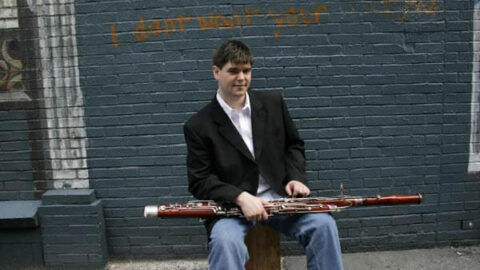 Composer Joan Tower’s newest work, Red Maple, premiered on October 4, 2013, at the Koger Center for the Arts at University of South Carolina in Columbia. Commissioned by a consortium of orchestras including the South Carolina Philharmonic and the virtuoso bassoonist Peter Kolkay, Red Maple is scored for solo bassoon and orchestral strings. It eschews splashy colors, heavy-handed percussion, and fanfarish settings, favoring an understated, perhaps restrained, accompaniment in order to let the soloist soar. Considering the remainder of the program – Tchaikovsky’s Fourth Symphony and the “Triumphal March and Ballet” from Verdi’s Aida – this bit of reflection and purity of scope was a welcome addition.
Composer Joan Tower’s newest work, Red Maple, premiered on October 4, 2013, at the Koger Center for the Arts at University of South Carolina in Columbia. Commissioned by a consortium of orchestras including the South Carolina Philharmonic and the virtuoso bassoonist Peter Kolkay, Red Maple is scored for solo bassoon and orchestral strings. It eschews splashy colors, heavy-handed percussion, and fanfarish settings, favoring an understated, perhaps restrained, accompaniment in order to let the soloist soar. Considering the remainder of the program – Tchaikovsky’s Fourth Symphony and the “Triumphal March and Ballet” from Verdi’s Aida – this bit of reflection and purity of scope was a welcome addition.

Of the seventeen-minute work (Tower is notorious for her distrust of movement structures), Tower states that she desires the bassoonist to simply “shine” throughout. The concert’s soloist did just that. Kolkay is one of the few bassoon superstars (let that phrase reverberate for a minute) able to fill a concert hall while maintaining a luscious, mellifluous sound. In this respect, Red Maple succeeds wildly. The work opens with a descending three-note chromatic motif and an extended, languorous, almost-plaintive solo in a fairly high register, perhaps a reach back in time to the inner movement of Gordon Jacob’s bassoon concerto or the slower passages of Taafe Zwilich’s concerto. Kolkay’s robust, confident, and energetic performance carried the work. If there is any doubt about Kolkay’s aptness for luminosity in lyricism, let it be laid to rest here and now.
Red Maple has a slow structural burn that gently draws listeners in and engages imaginations as it unfurls. The formal scope of the work is an interesting conceit and clever play on the concerto form. Just as autumn rushes in and sets forth a sense of urgency, so too does Red Maple, with an acceleration of contrasting ideas. The extended solo gives way to stilled string writing. From this slowness emerges faster sections, and these temporal variations alternate, each alternating section appearing to shorten in duration as the work moves toward its terminus. Tower works in three separate cadenzas and touches upon classical expositional ideas. Along the way there is a great deal of vivacity, with multiple gigue-like sections and rhythmically propulsive passages. A hurriedness-at-the-coda, last-breaths-of-Fall idea permeates the bassoon solo, too. As the work progressed, the level of technical skill in the bassoon increased, departing with a flurry of smoldering flourishes that summarily tested Kolkay’s mettle, almost a game of one-upping between Tower and the soloist. Kolkay accepted the dares and blazed through these sections with vigor and aplomb.

The string orchestra accompaniment in Red Maple was technically strong and expressively rich under Maestro Morihiko Nakahara’s baton. Yet, simultaneously, the scoring of the work seemed almost risk-averse. There is a general absence of percussiveness or novelty in timbre, and the strings remain in comfortable ranges. Many special effects are absent, from both soloist and strings. Granted, concerns of orchestration are paramount when composing for a bassoon as featured performer with any ensemble, but the approach here is almost too reductive. This does not, however, detract significantly from the work, a work bassoonists should be clamoring to perform, perhaps in slightly smaller venues, as the scoring and overall tenor of the piece suggests a certain kind of intimacy that may get lost in the upper balcony.
Rare indeed is the orchestra and the music director who take a chance on a premiere of a bassoon concerto. The South Carolina Philharmonic, music director Nakahara, and bassoonist Kolkay should be celebrated for empowering Tower to create this new work. Tower, likewise, should be thanked and saluted for taking up the challenge, especially for a premiere in a sleepy (yet culturally alive) town in the Deep and Dirty South. Red Maple will surely go into leaf as time wears on and Kolkay reprises his stellar performance beyond Columbia, SC.
























